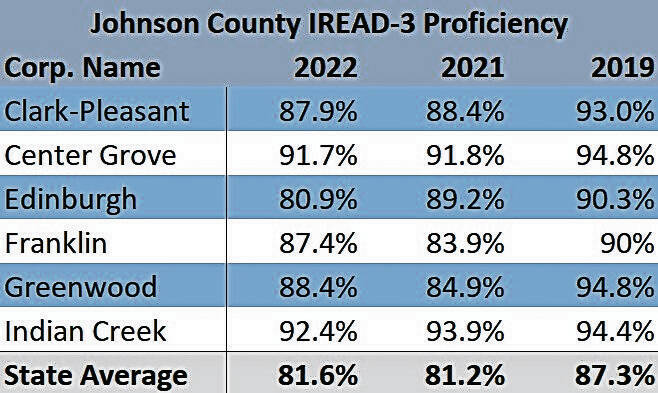All but one Johnson County school district outperformed the Indiana average for reading proficiency among third graders this year. Most school districts either stayed close to their marks from 2021 or improved upon them.
The proficiency ratings come from the IREAD-3 exam, which tests third graders’ proficiency in reading, including the identification of word sounds and knowing their meaning. Five Johnson County school districts had more than or close to 90% of third graders meet proficiency in the exam. Students at Edinburgh Community School Corporation were at 80.9% proficiency, which is just short of the state average of 81.6%, according to data from the Indiana Department of Education, or IDOE.
Edinburgh school’s figure is a steep decrease from the 89.2% proficiency rate the district had in 2021. The third graders who took the IREAD exam in the spring had their early academic careers severely impacted by the pandemic. They also aren’t the same students that took the exam the previous year, Superintendent Ron Ross said in an email.
“Each group has their own strengths and areas for growth,” Ross said. “This group of third graders haven’t had a normal year of school since they were kindergartners. We will analyze the various assessment data available to us to determine our students’ needs. Like most schools, we are seeing the results of the pandemic on our students.”
All six county school districts have dropped in IREAD proficiency level compared to 2019, before the COVID-19 pandemic. Greenwood Community School Corporation officials saw third-grade reading proficiency plummet the most, from 94.8% in 2019 to 84.9% in 2021, but it rebounded 3.5% in 2022, the same percentage bounced back Franklin Community School Corporation students had from last year to this year.
Some of the rebound is because students spent more time in classrooms during the 2021-22 school year compared to the previous two academic years, said Lisa Harkness, director of curriculum, instruction and assessment at Greenwood schools.
“Most schools are not at the pre-pandemic stage, but we are closing the gap,” Harkness said. “When we left school in March 2020, there were still 2 ½ months of school left. For a lot of kids in grades kindergarten, one or two, there was a huge amount of reading instruction they missed. Teachers tried hard to replace the instruction missed, but nothing replaces being in front of teachers.”
This spring, IDOE offered schools the opportunity to test second graders, who then wouldn’t have to test again in third grade if they passed. Administrators at Greenwood schools took that opportunity, and can now look at areas last year’s second graders had trouble in as they get them up to speed this year, she said.
“We have intervention time in all our buildings. During that time, we see where the deficits are or areas they need to grow, and students have intervention during that time,” Harkness said. “It could be a computer program, Orton-Gillingham, and we have other research-based resources once we identify what their academic needs are.”
Orton-Gillingham, multi-sensory phonics training, is also used by Franklin schools, and the diagnostic approach to literacy can help students who have dyslexia, said Brooke Worland, the school district’s assistant superintendent.
“Other things we’ve been doing, we’re already looking at robust ways to measure our summer school programs. We have reading clubs for third-grade students who may need extra time. We have tutoring opportunities and a partnership with Sylvan Learning Center,” Worland said. “We’re looking to start even earlier in filling literacy gaps with some of our students in the kindergarten, preschool area, students we can identify and boost so they’re even more prepared.”
Indian Creek schools had the highest reading proficiency in the county, at 92.4%, despite a 1.5% decrease from the previous year. The school district’s third graders even outperformed the average Indiana third-grade private school student. The state’s private schools had an average of 91.9% proficiency, according to data from the Indiana Department of Education.
At Indian Creek Intermediate School, which includes third through fifth-grade students, teachers look at what students need to improve upon if they don’t pass the exam in the spring and need to take it a second time in the summer. The exam also is a true measure of a student’s grasp of literacy, rather than an exam that students just prepare for and then forget, said Kim Davis, principal.
“We’re always looking at the daily classroom feedback teachers are giving us. With benchmark assessments, we improve things every year for kids,” Davis said. “I’m impressed with the success last year and we’ll try to meet the mark this year and try to outdo our own scores.”





